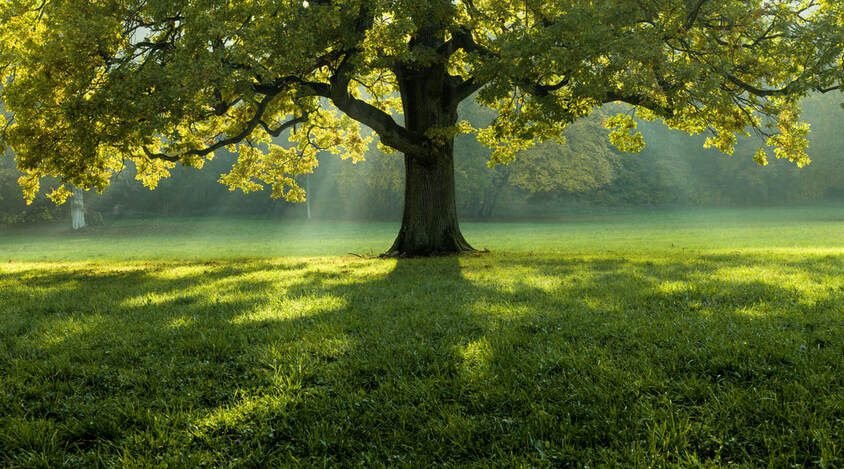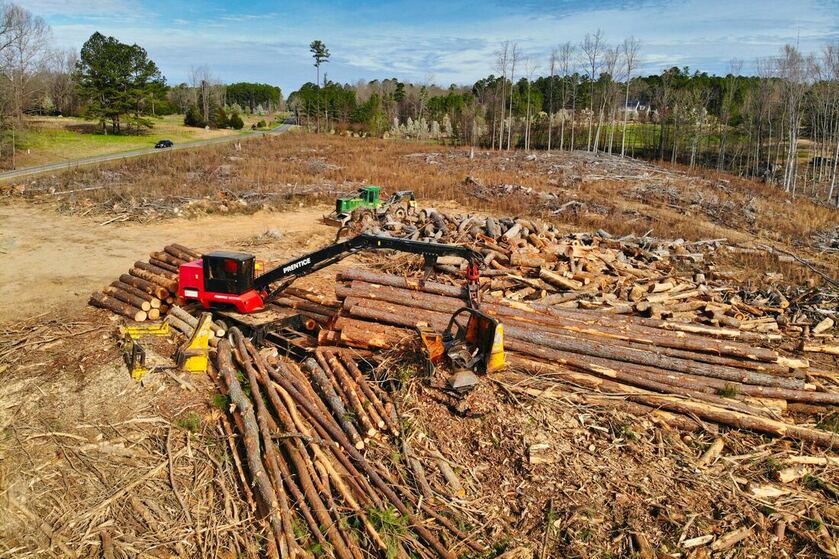
 Mother Nature provides services to you free of charge every day. These services protect your home, protect your health, and save you money. And these pro bono services take place right in your yard! Maintaining an intact ecosystem at home will guarantee you benefit from these services for the duration of your homeownership. In this fifth post of the Regenerative Design Series, I discuss the ecosystem services Mother Nature provides and how you can take advantage of an intact ecosystem at home. The Ecosystem Services of Your Yard The services Mother Nature provides free of charge include:
Benefits increase over time and are maximized by greater biodiversity. This means that the longer the ecosystem has remained intact on your property the better that ecosystem is able to clean your air, filter your water, shade your home, and mitigate flooding and erosion. When the land is cleared, you not only remove all the plant life. You also remove the microbiome. Trying to reestablish a lush green yard on compacted nutrient deficient soil is an expensive uphill battle I promise you don’t want to traverse. 3 Benefactors of Your Ecosystem at Home Here we will discuss the 3 main elements of your yard that provide free ecological services and contribute to a healthy ecosystem. Each component has tremendous value built into it by Mother Nature. When these aspects of your yard are disturbed, the hidden costs to regenerate them skyrocket. The 3 main contributors are:
Ecosystem Services Provided by Soil We walk on it all day long. Never paying soil any mind. Failing to realize it’s the substrate on which we build our lives and our health. Soil is not an inert growing medium – it is a living and life-giving natural resource. It is teaming with billions of bacteria, fungi, and other microbes that are the foundation of an elegant symbiotic ecosystem,” - Natural Resources Conservation Service Healthy soil is responsible for:
Healthy undisturbed soil is porous, containing about 50% air by volume. The open spaces among individual granules serve 4 main functions:
Healthy soils support the success and beauty of the entire ecosystem around your home. Without healthy soil you cannot have a healthy yard with strong tall trees or lush green grasses. The best way to care for healthy soil is to simply leave it alone. Undisturbed soil naturally maintains it’s healthy structure and microbiome. Not sure if your soil is healthy? Get your soil tested by your local Cooperative Extension office or another reputable soil lab. How do you prevent soil compaction during home construction? Stay tuned for our future blog that will discuss prevention methods and solutions for compact soils. Ecosystem Services Provided by Trees We often regard trees as only aesthetically beneficial. Sure, we know that trees produce the precious oxygen we need to breathe. However, rarely do we fully acknowledge the tremendous benefits trees provide for our overall health, the health of the planet, and the health of our homes. Healthy trees are responsible for:
Trees make you healthier and happier! They remove air pollution by intercepting particulate matter on its surfaces and by absorbing gaseous pollutants through its leaves. A study conducted by the Forest Service and The Davey Institute found the removal of air pollutants “can produce substantial health benefits and monetary values across the nation, with most of the health values derived from urban trees.” The trees on your property have a direct impact on the air you breathe. Trees also have a direct impact on your mental health. Research by Dr. Roger Ulrich found that “visual exposure to settings with trees has produced significant recovery from stress within five minutes.” Trees provide financial benefits by shading your home and reducing cooling costs, slowing harsh winds and reducing heating costs, protecting your home from the elements, and adding property value. According to the US Department of Agriculture the “net cooling effect of a young, healthy tree is equivalent to ten room-size air conditioners operating 20 hours a day.” Proper placement of trees around your home can reduce air conditioning needs by 30% and can save 20-50% in energy used for heating! And big, beautiful trees in your landscaping can increase property values as much as 20%. As trees grow, they take in carbon from the air and store it in wood, plant matter, and the soil. Absorbing and holding carbon dioxide that would otherwise remain in the atmosphere. In one year, a mature tree can absorb more than 48 pounds of carbon dioxide. Making them one of earth’s greatest “carbon sinks.” Keeping mature trees alive and healthy allows them to continue this valuable service. How do you conserve trees when clearing land to build a home? Stay tuned for our future blog that discusses tree conservation techniques. Ecosystem Services Provided by Native Plants It’s easy to assume all plants are the same. However, non-native plant species do not provide the same ecosystem services that native plants do. Native plants contribute to:
Diverse native plant communities in your yard provide food and shelter for butterflies, bees, birds, and other wildlife. They can even provide food for you and your family if you select edible native plants for your yard. Native plant communities are much more effective at slowing water movement and preventing flooding than mown turf or monoculture non-native grasses. Native plants play a major role in oxygen production and carbon sequestration. They absorb carbon dioxide from the atmosphere and store the carbon in their roots and stems, while releasing oxygen for us to breathe. They’re able to perform this service with less water than non-native plants. They’re more adapted for survival in your local area. Making native plants easier to care for and requiring less maintenance. Native plants can increase your property value! An Ecological Services study showed that it takes $3,000 to maintain an acre of native plants over 20 years and $20,000 for non-native plants. Landscaping yields the highest return of all home improvements. At an average of a 109% return on every dollar spent! With native plants as part of your home’s ecosystem you can:
As with all things cyclical in nature, each contributor to your ecosystem is dependent on the others. Soil, trees, and native plant life need each other to thrive. Keeping an ecosystem intact means conserving all three components. What Do You Do When It’s Time to Build? What do you do when it comes time to clear your land to build your home? Should you do what is customary and clear the land like many builders suggests? Maybe you can just add more trees and grass later? This would be a big mistake! And unfortunately, it’s the choice that most people make! There are hidden costs to disturbing your ecosystem. Costs that can continue draining your bank account for the duration of your homeownership. Not to mention making your yard a dangerous place to visit. There are time, money, and conservation strategies for clearing what needs to go while keeping what is vital. Read our next blog to learn the Hidden Costs of a Disturbed Ecosystem at Home. I intend Mother Nature continues providing the services you deserve. And you repay her by letting her share her gifts with you. Inspired by you, Jenny Pippin, CPBD, FAIBD, CGP
Pippin Home Designs
0 Comments
Leave a Reply. |
AuthorI am Jenny Pippin, founder of Pippin Home Designs and creator of my own inspired living. I grew up as an ordinary southern girl, working in the fields of my family’s tobacco farm. It didn’t take me long to realize I had greater gifts and so I chose to step into my power and create my own path in life, inspired by my heart’s true passion. (More on my personal story HERE!) Archives
February 2024
Categories
All
|
Copyright 2020. Pippin Home Designs. All rights reserved.
ARCHITECTURAL DESIGN COPYRIGHT NOTICE
1987-2024 Copyright. Jennifer B. Pippin FAIBD, CPBD. Pertaining to all home designs, drawings, and photographic imagery of completed designs
presented herein. No part of the contents of the design work presented on this website may be reproduced or transmitted in any form or
by any means, electronic or mechanical, for the purpose of replication or adaptation. This material is intended to provide accurate and
authoritative information about the design abilities and expertise of Jennifer B. Pippin FAIBD, CPBD and Pippin Home Designs.
ARCHITECTURAL DESIGN COPYRIGHT NOTICE
1987-2024 Copyright. Jennifer B. Pippin FAIBD, CPBD. Pertaining to all home designs, drawings, and photographic imagery of completed designs
presented herein. No part of the contents of the design work presented on this website may be reproduced or transmitted in any form or
by any means, electronic or mechanical, for the purpose of replication or adaptation. This material is intended to provide accurate and
authoritative information about the design abilities and expertise of Jennifer B. Pippin FAIBD, CPBD and Pippin Home Designs.










 RSS Feed
RSS Feed
